Video lecture for this chapter
This material (including images) is copyrighted!.
See my copyright notice for fair use
practices. Select the photographs to display the original source in
another window.
Our view of the history of astronomy will now skip almost 1500 years to the next
major advances in astronomy. Europe was beginning to emerge from a long period
of instability in the Middle Ages. During the Middle Ages the Islamic civilization
had flourished in the Arabic countries. They had preserved and translated the
Greek writings and adopted the Greek ideals of logic and rational inquiry. Islamic
astronomers were careful observers of the sky and created accurate star catalogs
and tables of planet motions. Many of the names of the bright stars in our sky
have Arabic names (e.g., Deneb, Alberio, Aldebaran, Rigel to name a few).
For more about this, see the database
of Islam and astronomy (will display in another window). However,
advances in the explanations of the motions of the stars and planets were
made by astronomers in Europe starting in the 16th century.
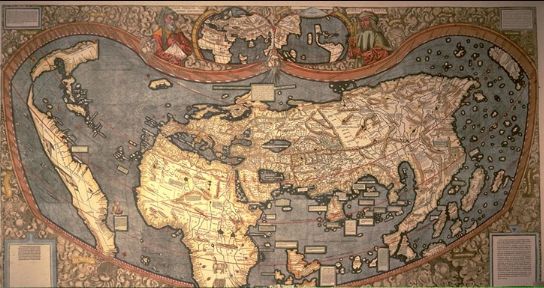
Martin Wallseemčller's world map of 1507. Select the image to go to Jim Siebold's Renaissance
maps database from which this picture came (will display in another window). This is the first map
that identified the
land across the Atlantic Ocean as ``America''. Exploration of that land was still quite
new.
By the 16th century the following paradigm had developed: Man is God's
special creation of the physical
universe; the Earth is the center of a mathematically-planned universe and we
are given the gift of reading this harmony. The Greek ideal of finding logical,
systematic explanations to physical events was rediscovered and celebrated to trading with
islamic nations. Along with this came an unbounded faith in the power of reason to solve
physical problems. This time in history is called the Renaissance (french for
``rebirth'').
Scientists use a guiding principle called Occam's Razor to
choose between two or more models that accurately explain the observations. This
principle, named after the English philosopher, William
of Occam, who stated this principle in the mid-1300's, says:
the best model is the simplest one---the one requiring the fewest
assumptions and modifications
in order to fit the observations. Guided by Occam's Razor some scientists
began to have serious doubts about Ptolemy's geocentric model in the early days
of the Renaissance.
 One such astronomer, Nicolaus
Copernicus (lived 1473--1543 C.E.), found
many deficiencies in the Ptolemaic model. He felt that any model of the planet
motions must account for the observations and have circular, uniform motion.
The Ptolemaic model did not do
that. Also, the Ptolemaic model was not elegant and, therefore, ``un-Godlike''.
During the years between Ptolemy and Copernicus, many small epicycles
had been added to the main epicycles to make Ptolemy's model agree with the
observations. By Copernicus' time, the numerous sub-epicycles and offsets had
made the Ptolemaic model very complicated. Surely, God would have made a
cleaner more elegant universe!
One such astronomer, Nicolaus
Copernicus (lived 1473--1543 C.E.), found
many deficiencies in the Ptolemaic model. He felt that any model of the planet
motions must account for the observations and have circular, uniform motion.
The Ptolemaic model did not do
that. Also, the Ptolemaic model was not elegant and, therefore, ``un-Godlike''.
During the years between Ptolemy and Copernicus, many small epicycles
had been added to the main epicycles to make Ptolemy's model agree with the
observations. By Copernicus' time, the numerous sub-epicycles and offsets had
made the Ptolemaic model very complicated. Surely, God would have made a
cleaner more elegant universe!
Copernicus was strongly influenced by neoplatonism (beliefs that combined elements of
Christianity and Platonism) in developing a model to replace Ptolemy's.
This led him to believe that the Sun is a material copy of God---God
is the creative
force sustaining life and the Sun gives us warmth and light. He
adopted Aristarchus' heliocentric (Sun-centered) model because he felt that
God should be at the center of the universe. Copernicus' model had the
same accuracy as the revised Ptolemaic one but was more elegant.
Copernicus retained the Aristotelian notion that planets
fulfill the goal of perfect (circular) motion. His model still used small
epicycles to get the details of the retrograde loops correct, though they were
only a minor feature. He used trigonometry to describe the distances of the
planets from the Sun relative to the astronomical unit (average
Earth-Sun distance), but he did not know the numerical
value of the astronomical unit. He found that the
planets farther from the Sun move slower. The different speeds of the planets
around the Sun provided a very simple explanation for the observed retrograde
motion.
Retrograde motion is the projected position of a planet on the
background stars as the Earth overtakes it (or is passed by, in the case of the
inner planets). The figure below illustrates this. Retrograde motion is just an
optical illusion! You see the
same sort of effect when you pass a slower-moving truck on the highway. As you
pass the truck, it appears to move backward with respect to the background
trees and mountains. If you continue observing the truck, you will eventually see
that the truck is moving forward with respect to the background scenery. The
relative geometry of you and the other object determines what you see projected
against some background.
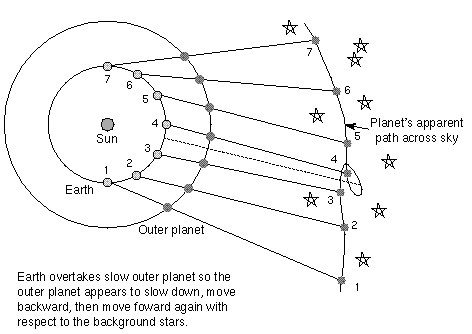
Select image to show animation of retrograde motion.
Copernicus thought his model was reality but other people used his model as
a more convenient calculation device only. If the Earth were moving around the
Sun, then the stars
should appear to shift due to our looking at them from different vantage
points in our orbit (a ``parallactic shift''). The parallax effect can be illustrated when you look at your thumb at arm's length with one eye and then the other---your thumb appears to shift position!
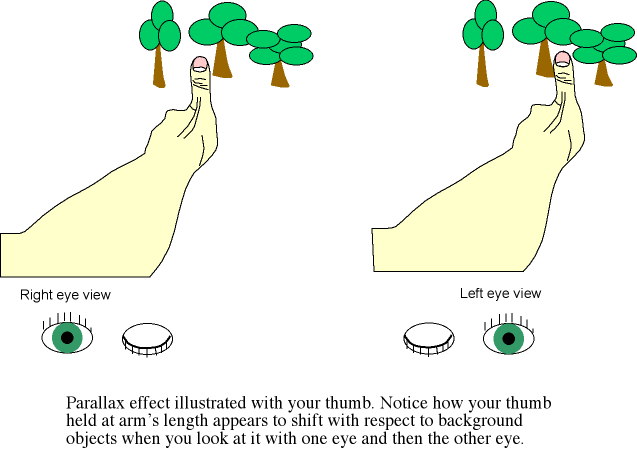
Now imagine that the Earth at opposite points in its orbit is your left and right eye and the nearby star is your thumb and you have the situation illustrated below.
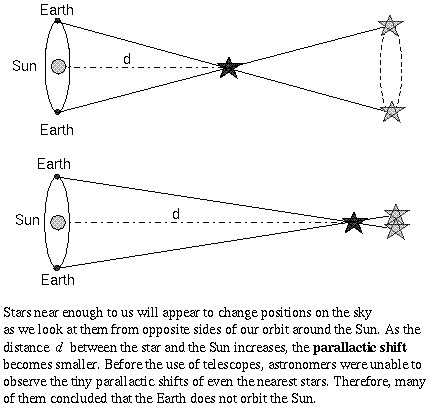
However, no
parallactic shift was observed in the stars. If there was actually a very small
parallactic shift, then
the stars would have to be very far away. Copernicus' contemporaries
felt that God would not waste that much space! They argued that, therefore, there must
be no parallactic shift at all---the Earth is not in motion. Astronomers
now know that the stars are indeed very far away and telescopes must be
used to detect the small parallactic shifts.
Try out the Solar
System Models module of the University of Nebraska-Lincoln's
Astronomy Education program for checking your understanding of the geocentric
vs. heliocentric model explanation of the planet motions (link will appear
in a new window) and use their Solar System Models Simulators in the Native Apps package (the Flash simulators no longer work with today's browsers).
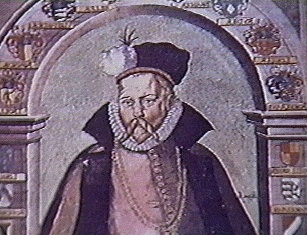 Tycho Brahe (lived 1546--1601 C.E.) revived Heroclides' model that had the
all of the planets,
except the stationary Earth, revolving around the Sun. Because Brahe was not a
neoplatonist, he
believed that the Sun, Moon, and stars revolved around the Earth.
Tycho's model was mathematically equivalent to Copernicus' model but did not
violate Scripture and common sense.
Tycho Brahe (lived 1546--1601 C.E.) revived Heroclides' model that had the
all of the planets,
except the stationary Earth, revolving around the Sun. Because Brahe was not a
neoplatonist, he
believed that the Sun, Moon, and stars revolved around the Earth.
Tycho's model was mathematically equivalent to Copernicus' model but did not
violate Scripture and common sense.
Tycho calculated that if the Earth moved, then the stars are at least
700 times farther away from
Saturn than Saturn is from Sun. Since Tycho felt that God would not waste that
much space in a harmonious, elegant universe, he believed that the Earth was at
the center of the universe. Astronomers now know that the nearest star is over
28,500 times farther away than Saturn is from the Sun!
Though Tycho's beliefs of the universe did not have that much of an effect on
those who followed him, his exquisite observations came to play a key role in
determining the true motion of the planets by Johannes Kepler. Tycho was
one of the best observational astronomers who ever lived. Without using a
telescope, Tycho was able to
measure the positions of the planets to within a few arc minutes---a
level of precision and accuracy that was at least ten times better than anyone
had obtained before!
 Go back to previous section --
Go back to previous section --
 Go to next section
Go to next section
last updated:
January 21, 2022
Is this page a copy of Strobel's
Astronomy Notes?
Author of original content:
Nick Strobel

 One such astronomer, Nicolaus
Copernicus (lived 1473--1543 C.E.), found
many deficiencies in the Ptolemaic model. He felt that any model of the planet
motions must account for the observations and have circular, uniform motion.
The Ptolemaic model did not do
that. Also, the Ptolemaic model was not elegant and, therefore, ``un-Godlike''.
During the years between Ptolemy and Copernicus, many small epicycles
had been added to the main epicycles to make Ptolemy's model agree with the
observations. By Copernicus' time, the numerous sub-epicycles and offsets had
made the Ptolemaic model very complicated. Surely, God would have made a
cleaner more elegant universe!
One such astronomer, Nicolaus
Copernicus (lived 1473--1543 C.E.), found
many deficiencies in the Ptolemaic model. He felt that any model of the planet
motions must account for the observations and have circular, uniform motion.
The Ptolemaic model did not do
that. Also, the Ptolemaic model was not elegant and, therefore, ``un-Godlike''.
During the years between Ptolemy and Copernicus, many small epicycles
had been added to the main epicycles to make Ptolemy's model agree with the
observations. By Copernicus' time, the numerous sub-epicycles and offsets had
made the Ptolemaic model very complicated. Surely, God would have made a
cleaner more elegant universe!



 Tycho Brahe (lived 1546--1601 C.E.) revived Heroclides' model that had the
all of the planets,
except the stationary Earth, revolving around the Sun. Because Brahe was not a
neoplatonist, he
believed that the Sun, Moon, and stars revolved around the Earth.
Tycho's model was mathematically equivalent to Copernicus' model but did not
violate Scripture and common sense.
Tycho Brahe (lived 1546--1601 C.E.) revived Heroclides' model that had the
all of the planets,
except the stationary Earth, revolving around the Sun. Because Brahe was not a
neoplatonist, he
believed that the Sun, Moon, and stars revolved around the Earth.
Tycho's model was mathematically equivalent to Copernicus' model but did not
violate Scripture and common sense.